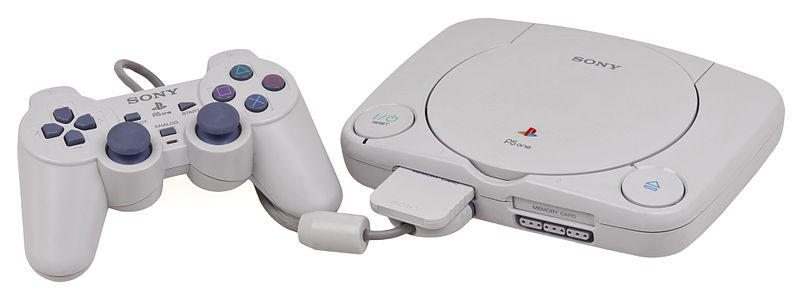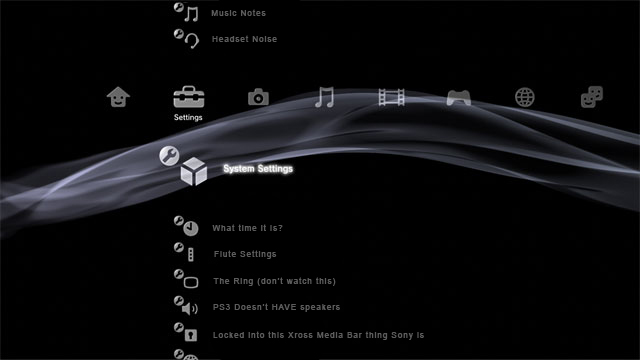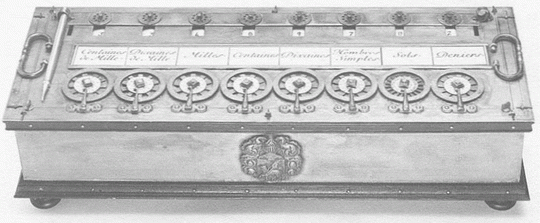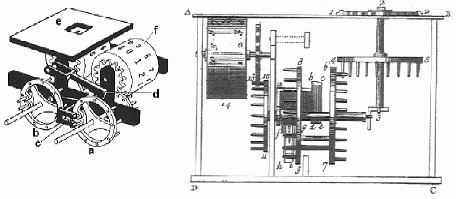1st Generation: (1972 - 1977)
Magnavox Odyssey
The Odyssey started off as a prototype in 1967 known as "brown box" by Ralph Baer (also known as the father of video games). In 1969, Baer tried to obtain a license agreement with various television companies. The agreement was signed by Magnavox. Then on January 27th 1972, the first home console was released as the Magnavox Odyssey priced at around 100 dollars. The Odyssey was advertised by the company to work only on Magnavox television sets as to increase TV sales. Over its 3 year life span, it only sold 200,000 units.
Technical specifications: The system contained no processor or memory.It was made up of transistors, capacitors and resistors. The system used cards to provide it with settings for the game to be played. All the games were variations of "pong" which used a "ball and paddle" mechanism first release by Atari. The games were played by two players with one controller each which have a dial.
According to the different game played, plastic overlays would be attached on the television set to provide a coloured scene for the game. The actual display was a black screen with white boxes which formed the "ball and paddle". The Odyssey originally came with six games and a 36 page manual for the other 12 games offered for the system. The total number of games released on this system were 28.
References:
Magnavox Odyssey | Video Game Console Library. 2015.
Magnavox Odyssey | Video Game Console Library. [ONLINE] Available at:
http://www.videogameconsolelibrary.com/pg70-odyssey.htm#page=reviews. [Accessed 07 March 2015].
Odyssye history. 2015.
Odyssye history. [ONLINE] Available at:
http://www.magnavox-odyssey.com/Odyssey%20history.htm. [Accessed 07 March 2015].
A History of Home Video Game Consoles | First Generation: 1972-1977 | InformIT. 2015.
A History of Home Video Game Consoles | First Generation: 1972-1977 | InformIT. [ONLINE] Available at:
http://www.informit.com/articles/article.aspx?p=378141. [Accessed 07 March 2015].
2nd Generation: (1976 - 1984)
Atari 2600
The Atari 2600 was first released on September 11, 1977 by Atari as the Atari VCS (Video Computer System) with nine games. The 2600 featured a new control system using an eight way controller stick with one button. Until the release of the "NES" in 1984, The 2600 was the best selling console of all time with 80% of the market share and over 400 games released for it. Atari and its 2600 were very popular until the video game crash in 1983. This was due to mismanagement and the release of the much hyped video game called E.T.: The Extra Terrestrial which proved to be a failure.
On the Atari 2600, the programmer had to individually program each line being drawn on screen. On each line, there could only be six objects: a "playfield", two "players", one "ball" and two "missiles". The names of the objects were only internal names. The "missile" does not need to be an actual missile.
Technical specs:
TIA 1A - Television Interface Adaptor Model 1A (Video, Audio, Input Ports) (Collision control system)
CPU 6507 - 8bit, 1.19MHz
RAM: 128 Bytes
Resolution: 160x192 pixels (NTSC 60Hz), 160x228 pixels (PAL 50Hz)
Colors: 4 colors at once (one color per object)
Palette: 128 colors (NTSC), 104 colors (PAL)
References:
Atari 2600 Specifications. 2015.
Atari 2600 Specifications. [ONLINE] Available at:
http://problemkaputt.de/2k6specs.htm. [Accessed 07 March 2015].
Inside the Atari 2600 | Hardware Secrets. 2015.
Inside the Atari 2600 | Hardware Secrets. [ONLINE] Available at:
http://www.hardwaresecrets.com/article/Inside-the-Atari-2600/1552/3. [Accessed 07 March 2015].
AtariAge - Atari 2600 History. 2015.
AtariAge - Atari 2600 History. [ONLINE] Available at:
https://atariage.com/2600/. [Accessed 07 March 2015].
Generations of video games - Sega Retro. 2015.
Generations of video games - Sega Retro. [ONLINE] Available at:
http://segaretro.org/Generations_of_video_games#First_generation. [Accessed 07 March 2015].
3rd Generation: (1983 - 1992)
Sega Master System
 The "Sega Master System" or "SMS" was released in 1986 by "Sega". The SMS was a cartridge-based system and uses an 8-bit processor. The SMS joy pad is called the "Master System Control Pad" which utilizes a D-pad (with thumb stick) on the left side, and 2 buttons on the right. Button "1" also functioned as the "Start" button. To pause a game on the system, the user would have to press the pause button which is found on the console itself. A direct competitor of this console was the "NES" by "Nintendo". The SMS wasn't as popular as the NES in Japan, but it outsold the NES in Europe and South America. The SMS sold over 14.8 million units worldwide and is know to be the second best console in this generation (3rd generation).
This console supports 8x8 or 8x16 sprites and supports horizontal, diagonal, vertical and partial screen scrolling.
Technical Specifications:
CPU: 8-bit Zilog Z80 3.54 MHz processor
RAM: 8KB
Graphics: VDP (Video Display Processor)
Video RAM: 16KB
Colours: up to 32 simultaneous colours (from a palette of 64 colours)
Resolution: 256x192 and 256x224
Sound: (PSG) Texas Instruments SN76489 which supports 4 channel mono sound and has 3 sound generators.
The "Sega Master System" or "SMS" was released in 1986 by "Sega". The SMS was a cartridge-based system and uses an 8-bit processor. The SMS joy pad is called the "Master System Control Pad" which utilizes a D-pad (with thumb stick) on the left side, and 2 buttons on the right. Button "1" also functioned as the "Start" button. To pause a game on the system, the user would have to press the pause button which is found on the console itself. A direct competitor of this console was the "NES" by "Nintendo". The SMS wasn't as popular as the NES in Japan, but it outsold the NES in Europe and South America. The SMS sold over 14.8 million units worldwide and is know to be the second best console in this generation (3rd generation).
This console supports 8x8 or 8x16 sprites and supports horizontal, diagonal, vertical and partial screen scrolling.
Technical Specifications:
CPU: 8-bit Zilog Z80 3.54 MHz processor
RAM: 8KB
Graphics: VDP (Video Display Processor)
Video RAM: 16KB
Colours: up to 32 simultaneous colours (from a palette of 64 colours)
Resolution: 256x192 and 256x224
Sound: (PSG) Texas Instruments SN76489 which supports 4 channel mono sound and has 3 sound generators.
References:
Sega Master System - Sega Retro. 2015. Sega Master System - Sega Retro. [ONLINE] Available at: http://segaretro.org/Sega_Master_System. [Accessed 10 May 2015].
Control Pad (Master System) - Sega Retro. 2015. Control Pad (Master System) - Sega Retro. [ONLINE] Available at: http://segaretro.org/Control_Pad_%28Master_System%29. [Accessed 10 May 2015].
Generations of video games - Sega Retro. 2015. Generations of video games - Sega Retro. [ONLINE] Available at: http://segaretro.org/Generations_of_video_games. [Accessed 10 May 2015].
4th Generation: (1987 - 1996)
Sega Mega Drive / Sega Genesis

The "Sega Mega Drive" (called Sega Genesis in America) is a console released by "Sega" in 1988. The Mega Drive was a direct competitor of Nintendo's "NES" and "Super Nintendo Entertainment System" (or SNES). The mega drive was Sega's most successful console with more than 40 million units sold worldwide and over a thousand games released for it. The Mega drive featured a newly designed controller which had a more ergonomic design and featured a new button (C). This console uses a 16-bit processor which enabled game developers to provide more realistic graphics than ever before.
As years went by, an array of addons were released for this system the Sega Mega Dive including the "Sega Mega CD" which enabled the user to play games which were on CD's instead of cartridges.
Due to its popularity, game collections are being released on the latest consoles as well like the PS3.

Technical Specifications:
CPU:16-bit Motorola 68000 7.67MHz
RAM: 64KB
Graphics: "VDP" - "Video Display Processor". Features four graphic layers.
Resolution: 320x224, 256x224
Colours: 512 colours total. Able to display up to 61 colours simultaneously.
VRAM: 64KB
Sound CPU: Zilog Z80 3.58 MHz, Yamaha YM2612 clocked at 68000 clock speed (6 channel audio)
Inputs: 2 male DE-9 controller ports and one female DE-9 expansion port
References:
Sega Mega-CD - Sega Retro. 2015.
Sega Mega-CD - Sega Retro. [ONLINE] Available at:
http://segaretro.org/Sega_Mega-CD. [Accessed 10 May 2015].
Sega Mega Drive - Sega Retro. 2015.
Sega Mega Drive - Sega Retro. [ONLINE] Available at:
http://segaretro.org/Sega_Mega_Drive#Technical_Specifications. [Accessed 10 May 2015].
Generations of video games - Sega Retro. 2015. Generations of video games - Sega Retro. [ONLINE] Available at: http://segaretro.org/Generations_of_video_games. [Accessed 10 May 2015].
5th Generation: (1993 - 2002)
Sony PlayStation / PSOne
 The "PlayStation" (PS) was first released in 1994 by "Sony" in Japan. The PlayStation did very well in Japan and in the US. Unlike previous generations, CD's were used. This allowed for more storage space and CD audio. Games were also easier to develop for the PS when compared to its competitors (Sega Saturn).
The "PlayStation" (PS) was first released in 1994 by "Sony" in Japan. The PlayStation did very well in Japan and in the US. Unlike previous generations, CD's were used. This allowed for more storage space and CD audio. Games were also easier to develop for the PS when compared to its competitors (Sega Saturn).
 Initially the controller for the PS was made up of 4 shoulder (back) buttons, a d-pad, start and select, and 4 action buttons. Later, Sony release a new controller which featured two thumb sticks (analog sticks) and a vibration function (called "DUALshock") which gave players hepatic feedback. Later in 1999, Sony released a smaller and more economic version of the PS called PSOne. Players were also able to "save" there progress in games by utilizing a proprietary memory card which holds 15 "blocks".
Initially the controller for the PS was made up of 4 shoulder (back) buttons, a d-pad, start and select, and 4 action buttons. Later, Sony release a new controller which featured two thumb sticks (analog sticks) and a vibration function (called "DUALshock") which gave players hepatic feedback. Later in 1999, Sony released a smaller and more economic version of the PS called PSOne. Players were also able to "save" there progress in games by utilizing a proprietary memory card which holds 15 "blocks".
 In 1991, PS was going to be an addon for the SNES, but the agreement didn't succeed.
In this generation, a large number of games true 3D graphics (with polygons) were being developed. This was possible due to the higher technical specifications of the console. The graphical capabilities of the PS include: 2D rotation, scaling,
transparency and fading and 3D texture mapping and shading. Apart from playing games, the PS could also be used as an Audio CD player.
In 1991, PS was going to be an addon for the SNES, but the agreement didn't succeed.
In this generation, a large number of games true 3D graphics (with polygons) were being developed. This was possible due to the higher technical specifications of the console. The graphical capabilities of the PS include: 2D rotation, scaling,
transparency and fading and 3D texture mapping and shading. Apart from playing games, the PS could also be used as an Audio CD player.
Technical specifications:
CPU: 32 bit RISC processor 33.9 MHz
RAM: 2MB
Graphics: 3D Geometry Engine
VRAM: 1MB
Colours: 16.7 million
Sprites: 4000 simultaneously
Polygons: 360000 per second
Resolution: 640x480
references:
Sony PlayStation 1st-gen specs - Engadget. 2015.
Sony PlayStation 1st-gen specs - Engadget. [ONLINE] Available at:
http://www.engadget.com/products/sony/playstation/1st-gen/specs/. [Accessed 13 May 2015].
Sony Playstation (History, Specs, Pictures). 2015.
Sony Playstation (History, Specs, Pictures). [ONLINE] Available at:
http://www.cyberiapc.com/vgg/sony_ps.htm. [Accessed 13 May 2015].
Generations of video games - Sega Retro. 2015. Generations of video games - Sega Retro. [ONLINE] Available at: http://segaretro.org/Generations_of_video_games. [Accessed 13 May 2015].
6th Generation: (1998 - 2006)
Sony PlayStation 2 / PS2
 The "PlayStation 2" (PS2) was first released in 1999 by "Sony" in Japan.
The "PlayStation 2" (PS2) was first released in 1999 by "Sony" in Japan. This was Sony's second console and was capable of millions of polygons per second which made game more life like than ever before. This console also featured the "Emotion Engine", thus enabling game characters to better react to player interaction and have more emotion. The PS2 now also used DVDs (and CDs) which allowed for much more storage than the CD. The PS2 also featured backward compatibility with its predecessor, the PlayStation 1. The PS2 can also be used as a CD and DVD player to listen to music or watch movies respectively. The controller used on the PS2 is the DualShock2 which is very similar to the DualShock controller of the PSone. The PS2 also featured the same saving system as the PSone which is memory cards although PS2 memory card hold 8MB compared to 1MB of the PSone. It is important to note that the PlayStation 2 is currently the best selling home console of all time having sold over 155 million units worldwide.
The PS2 also featured a LAN port for internet connection. Games could also support online multiplayer.

The PS2 also featured two USB ports which could be used to attach various accessories such as the "Eye toy" camera which can be used to play games with your body.

Technical specifications:
CPU: 128 bit "Emotion Engine" at 300MHz
RAM: 32MB direct RAMBUS (memory bus bandwidth 3.2 GB per second)
Co-Processor: FPU (Floating Point Accumulator, Floating Point Divider)
Vector Units: VU0 and VU1
Graphics: "Graphic Synthesizer" at 150MHz (max polygon rate: 75 million polygons per second)
VRAM: 4MB (bandwidth 48GB per second)
Resolution: SD and HD up to 480p (1080i for certain games)
Sound: "SPU2 + CPU" 48 channel (sample frequency: 44.1KHz or 48KHz)
References:
Sony PlayStation 2/PSTwo (PS2) Console Information. 2015.
Sony PlayStation 2/PSTwo (PS2) Console Information. [ONLINE] Available at:
http://www.consoledatabase.com/consoleinfo/sonyplaystation2/. [Accessed 17 May 2015].
Generations of video games - Sega Retro. 2015.
Generations of video games - Sega Retro. [ONLINE] Available at:
http://segaretro.org/Generations_of_video_games#Fifth_generation. [Accessed 17 May 2015].
7th Generation: (2005 - ongoing)
Sony PlayStation 3 / PS3

The "PlayStation 3" was first released by "Sony" in 2006. This was Sony's third home console following the PS2. Games for this system were being produced on Blu ray disks. This means that the games could be much larger and more complex than the games on previous generation consoles. Apart from playing games, the PS3 system had a graphical user interface called the XrossMediaBar (XMB).

Through the XMB, the user could set up various settings for the system and playback music, videos and pictures. The PS3 also featured the new DUALshock3 "sixaxis" wireless controller. The configuration for the buttons on the Dualshock3 is the same as the DUALshock2 with some small differences. The two trigger buttons (L2 and R2) where now pressure sensitive and a new button was introduced in the middle of the controller called the "PS button". The controller also has the "sixaxis" feature which enables the player to perform actions in game by moving the controller in a particular manner (depending on the game).

With the PS3, Sony also started the PlayStation Network (PSN) which is used by players to communicate and play together online. Along with the PSN, there was the PlayStation Store which was used to to purchase games and download them directly to the PS3 system. The PS3 featured a Hard disk Drive for storage. With an HDD, games could be installed on the system and media could also be stored on the system. The HDD also removed the need for external memory cards as the saved data is stored in the system.Till now the PS3 has seen three physical revisions as seen below:

Games for the PS3 featured high definition realistic graphics with stereoscopic 3D capability, but developers found it difficult to develop due to the new "Cell" processor architecture.
Technical Specifications:
CPU: Cell Processor 3.2GHz (512KB L2 Cache) 8 cores total (1 is left for redundancy)
RAM: 256MB XDR 3.2Ghz
GPU: Nvidia RSX 550Mhz (1.8 TFLOPS floating point performance) (full HD x2 channel)
VRAM: 256MB GDDR3 700MHz
Resolution: 480i, 480p, 720p, 1080i, 1080p
Ports: HDMI, USB, Ethernet, AV multi out, optical
Sound: RCA stereo, HDMI, Optical (5.1 surround support)
Optical media: DVD-video, CD, Blu ray, PlayStation format disk, PlayStation 2 format disk (only on initial systems), PlayStation 3 format disks.
References:
Sony PlayStation 3 specs - Engadget. 2015.
Sony PlayStation 3 specs - Engadget. [ONLINE] Available at:
http://www.engadget.com/products/sony/playstation/3/specs/. [Accessed 23 May 2015].
PS3 features | Unleash essential entertainment | PlayStation. 2015.
PS3 features | Unleash essential entertainment | PlayStation. [ONLINE] Available at:
https://www.playstation.com/en-gb/explore/ps3/features/. [Accessed 23 May 2015].
8th Generation: (2012 - ongoing)
Sony PlayStation 4 / PS4

The "PlayStation 4" was first released by "Sony" in 2013. This is Sony's fourth home console following the PS3. Like its predecessor, games come on blu ray discs which provide ample space for games. Sony decided to use a x86/64 AMD processor instead of using the "Cell" processor technology found in the PS3. This new processor makes it easier to develop for than the "Cell" processor. The PS4 features a new controller (DualShock4) which resembles the DualShock3, but has some key improvements. The controller is now generally more ergonomic and features a share button which allows the player to take a screen shot or save a video of their game play. The controller also features a touch pad in the middle of the controller which can have various uses in a game. The controller also has an in built speaker and a headset can be directly connected to it as well.

The PS4 aslo features a new GUI called "PlayStation dynamic interface" which is similar to the XMB on the PS3, but has more focus on the games and applications installed.

The PS4 allowed players to combine their PlayStation account with other social networking accounts to be able to stream or send video game play to each other. The PS4 also features a cross game voice chat system to be able to communicate with your friends even when playing different games.
Technical specifications:
CPU: AMD x86 "Jaguar" 8-core processor (with a weaker secondary CPU for background processes)
GPU: AMD next-gen Radeon based engine with 18 compute units (1.8 TFLOPS)
RAM: 8GB GDDR5 (Shared by CPU and GPU. Shared bandwidth of 176GB/sec)
Resolution: 720p, 1080i, 1080p, (4k for video and pictures)
Ports: USB 3.0, HDMI, Optical
Media: Blu-ray, DVD
Storage: HDD
References:
Playstation 4 Specs Guide . 2015.
Playstation 4 Specs Guide . [ONLINE] Available at:
http://www.ps4playstation4.com/Expected-PS4-Specs. [Accessed 24 May 2015].




